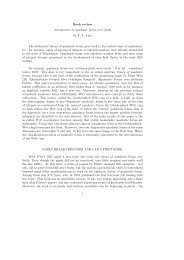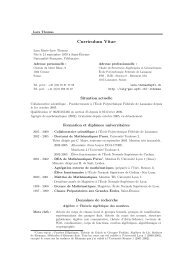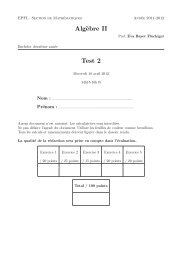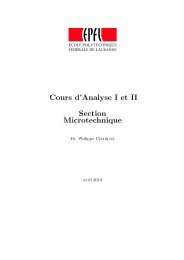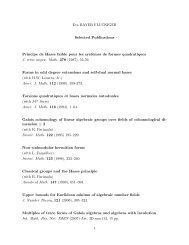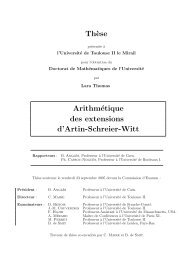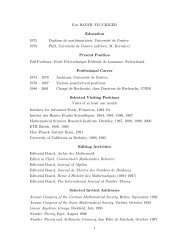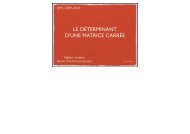Some remarks on orbit sets of unimodular rows - CSAG - EPFL
Some remarks on orbit sets of unimodular rows - CSAG - EPFL
Some remarks on orbit sets of unimodular rows - CSAG - EPFL
You also want an ePaper? Increase the reach of your titles
YUMPU automatically turns print PDFs into web optimized ePapers that Google loves.
8 J. FASEL<br />
which is a flasque resoluti<strong>on</strong> <strong>of</strong> a sheaf Gj <strong>on</strong> X. Here the groups ˜ Gj−p (k(xp)) are<br />
the fibre products<br />
˜G j−p (k(xp)) <br />
Ĩj−p (k(xp))<br />
<br />
KM j−p (k(xp))<br />
<br />
j−p <br />
I (k(xp)).<br />
Notice that the group ˜ G j−p (k(xp)) is also twisted by the vector space ωp. When the<br />
vector space is can<strong>on</strong>ically isomorphic to k(xp), we drop the twiddle. By definiti<strong>on</strong>,<br />
we get an exact sequence <strong>of</strong> sheaves <strong>on</strong> X<br />
0<br />
<br />
j+1 I <br />
j G <br />
M Kj for any j ∈ Z.<br />
If A be a smooth k-algebra <strong>of</strong> dimensi<strong>on</strong> d, the above sequence <strong>of</strong> sheaves gives<br />
an exact sequence<br />
H d (A, I j+1 )<br />
<br />
d j H (A, G )<br />
<br />
0<br />
<br />
d M H (A, Kj ) <br />
0<br />
for any j ∈ N. The natural map <strong>of</strong> sheaves G j+1 → I j+1 gives a surjective homomorphism<br />
H d (A, G j+1 ) → H d (A, I j+1 ) and we get an exact sequence<br />
H d (A, G j+1 )<br />
<br />
d j H (A, G )<br />
<br />
d M H (A, Kj ) <br />
0<br />
for any j ∈ N. By definiti<strong>on</strong>, H d (A, G d ) is the Chow-Witt group CH d<br />
(A) as<br />
defined in [3] or [12, Definiti<strong>on</strong> 10.2.14] and H d (A, K M d ) is the Chow group CHd (A).<br />
Putting everything together, we have:<br />
Propositi<strong>on</strong> 3.1. Let A be a smooth k-algebra <strong>of</strong> dimensi<strong>on</strong> d. There is an exact<br />
sequence<br />
H d (A, G d+1 )<br />
d<br />
<br />
CH (A)<br />
<br />
CH d (A)<br />
3.2. The sheaf K MW . First recall the following definiti<strong>on</strong> from [21, Definiti<strong>on</strong><br />
5.1]:<br />
Definiti<strong>on</strong> 3.2. Let F be a field (possibly <strong>of</strong> characteristic 2). Let KMW ∗ (F ) be the<br />
(unitary, associative) Z-graded ring freely generated by the symbols [a] <strong>of</strong> degree 1<br />
with a ∈ F × and a symbol η <strong>of</strong> degree −1 subject to the following relati<strong>on</strong>s:<br />
1. [ab] = [a] + [b] + η[a][b] for any a, b ∈ F × .<br />
2. [a][1 − a] = 0 for any a ∈ F × − {1}.<br />
3. η(η[−1] + 2) = 0.<br />
4. η[a] = [a]η for any a ∈ F × .<br />
There is a natural homomorphism K MW<br />
∗ (F ) → K M ∗ (F ) such that [a] ↦→ {a} and<br />
η ↦→ 0. For any n ∈ Z there is also a natural homomorphism KMW n (F ) → In (F )<br />
such that [a1] · [an] ↦→ 〈−1, a1〉 ⊗ . . . 〈−1, an〉 and η ↦→ 〈1〉 ∈ I−1 (F ) = W (F ) (this<br />
definiti<strong>on</strong> is also meaningful in characteristic 2, see [22, §2.1]). These homomorphisms<br />
coincide <strong>on</strong> I n (F ) and therefore yield a homomorphism KMW n (F ) → Gn (F )<br />
for any n ∈ Z. The expected result holds ([21, Theorem 5.3] if F is <strong>of</strong> characteristic<br />
different from 2, and [22, Remark 2.12] in characteristic 2):<br />
Theorem 3.3. The homomorphism KMW n (F ) → Gn (F ) is an isomorphism.<br />
<br />
0.



